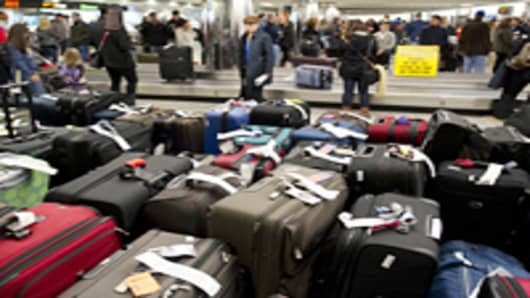With the busy summer travel season just months away, there’s good news and bad news on the baggage front.
The good news is that fewer checked bags are being damaged, delayed, pilfered, or lost. According to a new report from SITA, a provider of information technology to the airline industry, the total number of mishandled bags dropped 20.3 percent worldwide last year and is down by more than half since 2007.
“Last year was a fantastic year in the world of baggage, probably the best year ever,” said Nick Gates, SITA’s director of baggage solutions. The main reason, he told msnbc.com, was a Baggage Improvement Program developed by the International Air Transport Association (IATA).
The program is a multi-year effort to analyze where mishandling occurs and to train employees to share information on best practices for baggage handling. Covering 200 airports around the world, it’s targeted for completion this year and is expected to save the industry $1.9 billion annually.
Airlines mishandled 25.8 million bags worldwide last year, the SITA report shows, down from 32.3 million in 2010, despite carrying 6.9 percent more passengers (2.87 billion).
That translates into 8.99 mishandled bags per 1,000 passengers, a drop of 25.5 percent from 2010. In the U.S., the numbers were even better, dropping to 3.39 bags per 1,000 passengers (domestic flights only) from 3.51 bags in 2010, according to the Department of Transportation.
Some problems remain, especially in the realm of connecting flights, which accounted for 53 percent of all mishandled bags last year. “Transfers have always been a challenge and probably always will be,” said Gates. “If you’re flying from Point A to Point B, your bags are touched twice. If you’re flying from Point A to Point B to Point C, the number of touchpoints effectively doubles.”
The impressive baggage handling numbers have a flip side.
As things improve in the cargo hold, many passengers remain convinced that things are getting worse in the cabin as fee-averse travelers try to take more and bigger bags aboard.
“People are pushing the carry-on regulations to the limit,” said Michael Hess, president and CEO of bag maker Skooba Design and a longtime frequent flier. “It makes sense that there are fewer bags getting lost because there are fewer bags going into the baggage hold of the plane.”
Neither DOT nor the airlines track specific numbers, but as Bobbie Egan, spokesperson for Alaska Airlines told msnbc.com, “I think that, in general, the industry has seen an increase in carry-on bags.”
Some travelers try to cram bags into already packed overhead bins, impeding boarding procedures, while others take advantage of gate-checking, in which they give up their bags just before boarding, typically avoiding bag fees in the process.
Either way, for many travelers, the improvement in mishandled-bag rates is likely to be considered small consolation in light of the crush of carry-on bags in the cabin. In fact, according to a report issued by U.S. Travel, an industry trade association, last November, 72.4 percent of air travelers listed “people who bring too many carry-on bags through the security checkpoint” as one of their top five frustrations — more than any other complaint.
“All [the airlines] have done is move the problem from the belly of the plane to the cabin,” said Hess. “You sit there and someone comes in and insists they can fit their piano in the overhead bin. It’s ridiculous.”
SITA's Gates cautions against over-simplification. “There’s some evidence that the total number of checked bags is reducing slightly but the drop in mishandling rates far exceeds that,” he said. “I don’t think it has a significant impact on the overall data.”
This article originally appeared on MSNBC.com.


